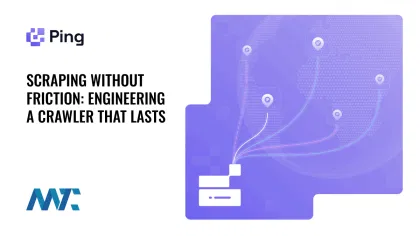
29.9% of all online traffic is bot traffic that’s scraping or retrieving data.
Cloudflare Radar
Web scraping is often portrayed as shady. In reality, it underpins many legitimate business activities. Companies scrape to migrate websites, capture competitor pricing, monitor their brand mentions, enrich data, and even re-purpose their own content across platforms. Because approximately one-third of scraping activity is malicious, this reality has led to the development of strong defenses.
That means scraping only works if it is engineered with care.
Table of Contents
The Reality of the Modern Perimeter
Security systems are designed to identify activity that does not appear to be typical of customers. Bursts of connections, incomplete technical handshakes, or unusual browsing patterns all trigger defenses. When that happens, businesses encounter error messages, slowdowns, or blocks that prevent the collection of data. Because bot traffic is such a large part of today’s internet, detection systems are highly tuned to catch even the most minor anomalies. For marketers and businesses, that means scraping requires discipline and planning, not just rotating IP addresses.
Bandwidth and Compute Math Most Teams Skip
Behind every scraping effort are very real costs. A typical webpage today is approximately 2 MB, with most of it comprising images, scripts, and other assets that are not relevant to the data. If your scraper downloads everything instead of focusing on the text or structured data you actually need, bandwidth bills rise quickly. Just one million uncompressed pages can run into five-figure cloud costs. Additionally, scraping with heavy tools, such as headless browsers, consumes a large amount of memory and computation, which further increases costs.
Efficient scrapers reduce waste. They reuse connections instead of establishing new ones, compress text data to reduce payloads, and cache assets to prevent repeated downloads. These optimizations mean more data for less money—a key consideration when building a sustainable data pipeline.
Practical Implications
The business takeaway is clear: how you scrape matters as much as what you scrape. A few simple best practices help balance cost and reliability:
- Prefer lightweight data sources, such as JSON feeds or simplified HTML, over full-page loads.
- Always accept and use compression to reduce data size.
- Cache repeated assets to avoid being billed multiple times.
- Reuse connections and keep sessions alive to look more like a real visitor and save resources.
These adjustments enable businesses to capture more data at a lower cost, with a reduced risk of being blocked.
Connection Behavior That Lowers Block Probability
To last, scrapers must mimic human browsing. That means setting headers (such as language, accepted formats, and device type) in the same way a real browser would. It means pacing requests instead of hammering servers with bursts of traffic. It also means respecting signals, such as a site’s robots.txt file, and slowing down if servers request it. These choices don’t just make a crawler harder to detect—they also help businesses avoid damaging relationships with sites they need to collect data from.
IP Strategies You Can Explain to Security Teams
A common mistake is thinking scraping is all about IP rotation. The truth is smarter: it’s about predictability and restraint. You can buy datacenter IPs and shape traffic to stay beneath rate and behavioral thresholds. Residential IPs can appear more like human traffic but come with a higher cost and complexity. Whichever approach is chosen, the key is moderation… gradually warming up new IP pools, keeping request rates modest, and sustaining longer sessions instead of constantly switching. Businesses that treat IPs like shared infrastructure, not disposable tools, end up with smoother, more predictable scraping.
Measure What Matters
A scraper that feels fast but quietly racks up blocks and retries is wasting money. That’s why measurement is critical. The most useful metrics are:
- Block Rate: How often pages return errors or challenges.
- Success Rate: How many pages return usable data.
- Latency: How quickly pages load, especially at scale.
- Freshness: How up-to-date your captured data is compared to source changes.
- Payload Efficiency: How many bytes you’re paying to move per useful record.
These measures tie directly to cost and business value. Lower block rates mean fewer retries, which saves bandwidth and time. Better efficiency reduces cloud bills. Monitoring freshness ensures your insights are timely and relevant.
Bringing It Together
Scraping is not about hacking—it’s about building a disciplined data collection system. Done right, it respects website perimeters, keeps costs in check, and produces reliable data streams that businesses can depend on. For marketers and executives, the takeaway is simple: sustainable scraping is an engineering discipline that protects budgets and ensures consistency.
By aligning with normal browsing behavior, reducing waste through compression and caching, reusing connections efficiently, and treating IP addresses responsibly, companies can gather the insights they need without friction.